Excerpts from Jim Conrad's
Naturalist Newsletter
from the April 14, 2008 Newsletter written in the community of 28 de Junio, in the Central Valley 8 kms west of Pujiltic, elev. ~700m (2300ft), ~N16.331°, ~W92.472°; southeastern Chiapas state, MÉXICO
BANANA-TREE FIBERS
Seeing the Streak-backed Oriole so easily dislodging one fiber after another from a banana tree, I went to see if I could do it. Once I began paying attention I decided that lots of birds must have been pulling out lots of fibers to cause the trees' leaves to be so tattered. You can see a really tattered blade below:
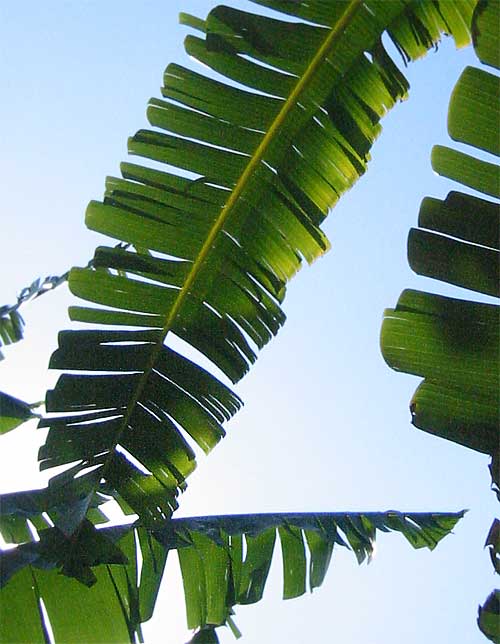
In that picture notice that here and there entire sections of leaf appear to have been removed. I felt sure that these were animal-made, but then I looked closely at how fibers were arranged in the leaf:
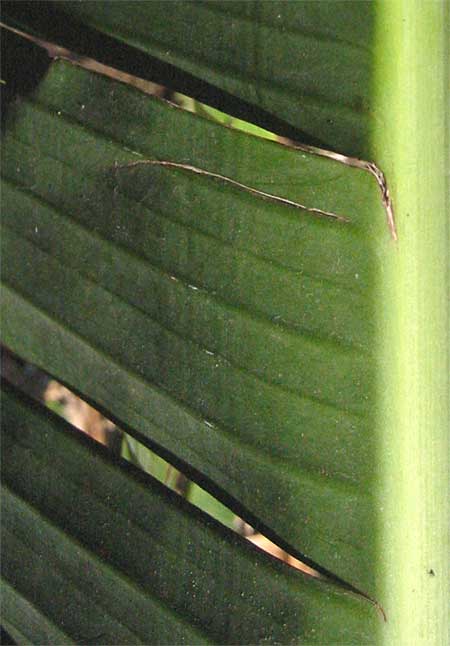
The fibers are actually parallel-running veins conducting water and the products of photosynthesis up and down the blade. Splits appear to develop naturally beside certain larger veins, then continue into the blade's midvein, angling toward the trunk. To extract a fiber I found it easiest to start tugging where the split enters the midrib and from what I can see orioles think the same. Also I found that fibers in old, dry leaves are too brittle, but those in young leaves are too weak. A leaf old enough to already have lots of splits in it is just right.
I suspect that orioles and other animals also use fibers from old banana-tree "trunks" (actually leaf petioles), for they are very fibrous, as shown below:
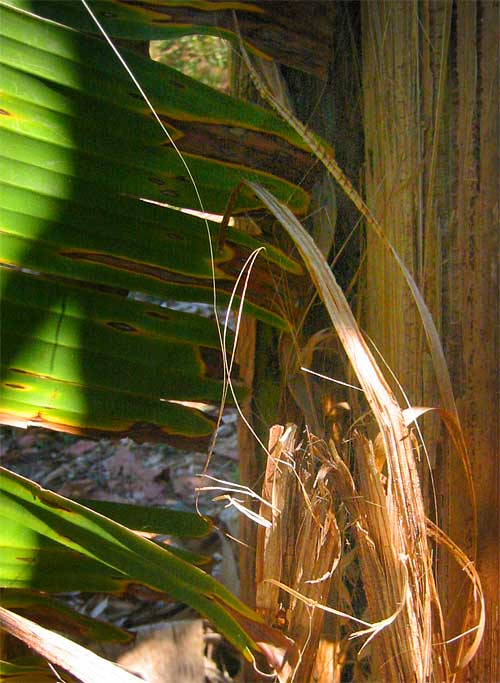
In fact, Nature is full of useful fibers. Often I see birds gathering them from palms. Remember back at Pollys Bend in Kentucky how House Finches gathered fiber from Paper Mulberries, and other times I've mentioned the strong fibers in nettles.
written in the community of 28 de Junio, in the Central Valley 8 kms west of Pujiltic, Chiapas, MÉXICO
CUTTING BANANA LEAVES
Banana trees are good for more than fibers and bananas. The other day Andrés took me along to cut banana leaves whose blades later would be fashioned into flat squares in which tamales would be wrapped for steaming.
Arriving at the plantation Andrés removed from his side-bag a short, curved, steel blade with the cutting edge on the inside curve. This he fitted onto a long pole, and then he proceeded to cut banana leaves. It was a simple operation of positioning a banana-leaf petiole inside the curved blade, and jerking downward. The six-foot blade would then flutter to the ground.
Once he'd cut about twenty blades he began gathering dry leaf-clutter from beneath trees and piling it into a heap. "It's too cold, so we need a fire," he joked in the 97° heat. We'd just been joined by our friend Pancho, who'd come to cut bananas for his family, and he, lying on the ground watching us, laughed so hard he had to hold his stomach. Then Andrés set fire to the dry leaf-trash and undertook the operation you can see taking place, with Pancho in the background, below:
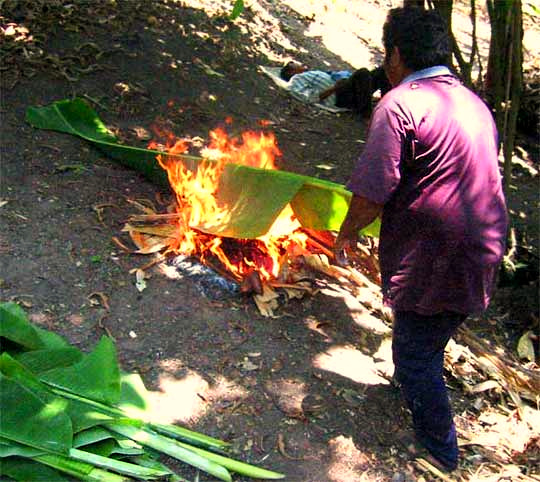
Andrés knew I didn't understand why he was doing this but he didn't offer a word. Instead, after he'd finished he cut a small square of unfired banana leaf and crumpled it in his hand. It was so brittle that it crunched and tore. Then he cut a similar square of a fired leaf, crumpled it, and it made no sound, didn't tear, but behaved like a moist cloth. All was clear.
Pancho found the notion that a big, smart gringo such as myself wouldn't know all this simple stuff so funny that once again he broke into hysterics, actually rolling on the ground. Though in our community, unlike so many others in the area, drunkenness isn't a problem, I thought that Pancho surely was drunk. But, no, later I could see that he was just happy to lie on the ground in the shade with a good breeze blowing, watching his friends work as he poked good-natured fun at them. The man was simply happy!
Andrés began cutting the leaves' flat side-blades from their stiff midribs while I folded the resulting sheets per his instructions. Several time Andrés asked, "It's interesting stuff, isn't it Jim?" and I'd say yes, and Pancho would laugh even harder than the last time.
You can see what Andrés looked like as I followed him home from the banana plantation, flat sheets of banana leaf compactly rolled and held in his headband gear, in his mecapal, over his shoulder, below:
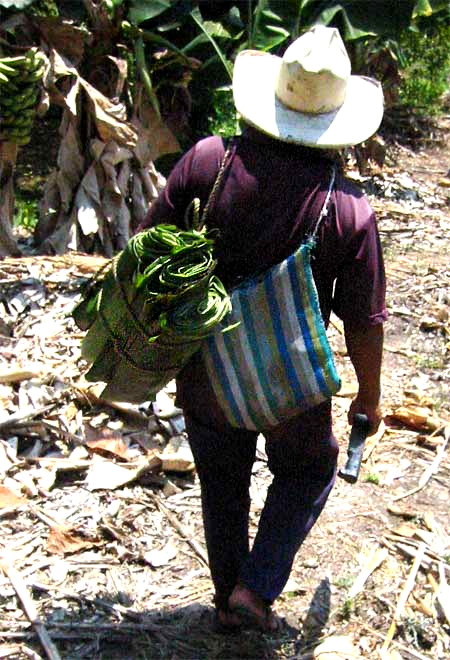
Sunday morning Andrés brought me some tamales wrapped in our banana leaf sections. Tamales are pillow-like packages of cooked corn stuffed with various ingredients. Mine were filled with a bean/tomato mix and wrapped in spicy leaves of Piper auritum, sometimes called Hoja Santa but here called Mu-mu. Then the Mu-mu package was wrapped in sheets of our banana leaves. During steaming the green Mu-mu leaf softens and blends with the corn package so I just bit through the Mu-mu as if it weren't there. The tamale was delicious and the Mu-mu flavor was a nice touch. You can see my tamale, green banana leaf at the left in the picture, the Mu-mu-encased tamale at the right, below:
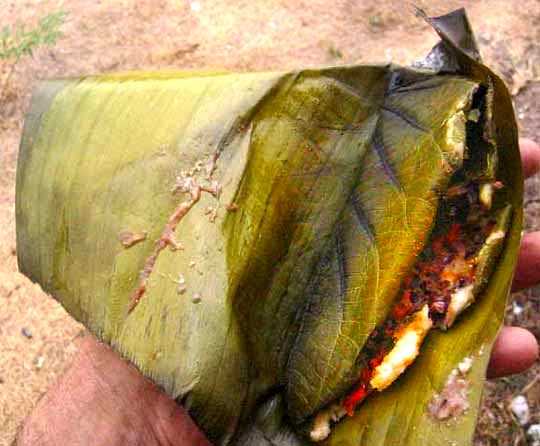
From the May 12, 2008 Newsletter written in the community of 28 de Junio and issued from a ciber in Venustiano Carranza, Chiapas, MÉXICO
BANANA TREE FLOWERS
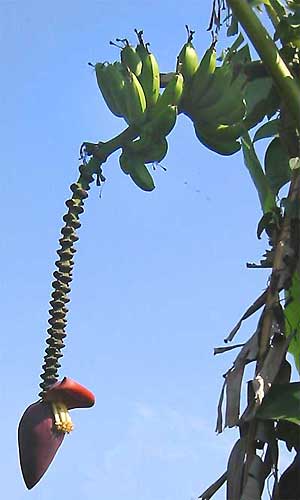
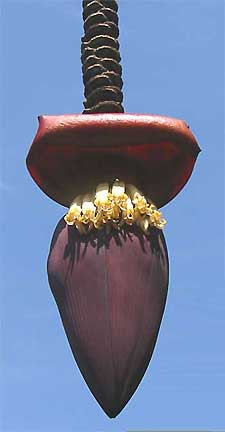 The picture above shows a stalk of ripening bananas. Or, more technically, it shows a drooping, spike-type cluster of flowers, or inflorescence, with female ovaries maturing into bananas at the base of the spike (top in the picture) and male flowers subtended by broad, colored bracts at the spike's tip (bottom in the picture).
The picture above shows a stalk of ripening bananas. Or, more technically, it shows a drooping, spike-type cluster of flowers, or inflorescence, with female ovaries maturing into bananas at the base of the spike (top in the picture) and male flowers subtended by broad, colored bracts at the spike's tip (bottom in the picture).
The picture at the right shows fifteen or so functionally male flowers that will never produce bananas, just pollen. The peeling-back, hoodlike thing above them is a bract, or modified leaf. The stem, or rachis, at the top of the picture shows many scars of previous bracts, so over time there's been a lot of male flowers shedding pollen from their anthers, then falling off, along with their bracts.
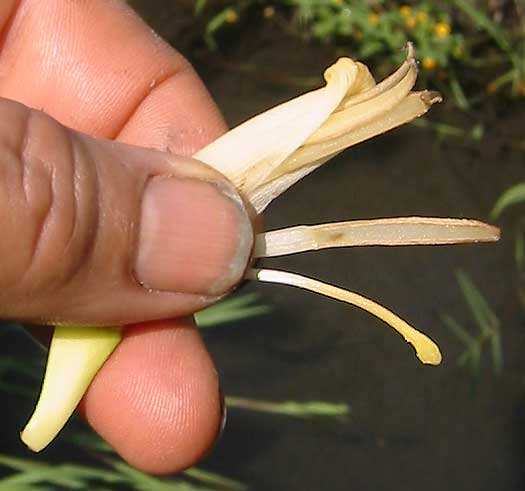
Above you can see a male flower. The flat, long item with powdery lines along its margins, extending from the center of my thumbnail, is a stamen. The powdery lines are pollen issuing from elongate anther sacs along the anther's margins. The blunt, yellow-tipped thing below that is a sterile staminode, probably evolved to give pollinators something to hold onto as they pull themselves into the flowers' throats dusting themselves with pollen.
So, banana flowers are unisexual, though when they first start developing sometimes you can find stamen- bearing flowers with ovaries. However, in flowers whose stamens eventually produce pollen, the ovaries abort and don't develop into bananas.